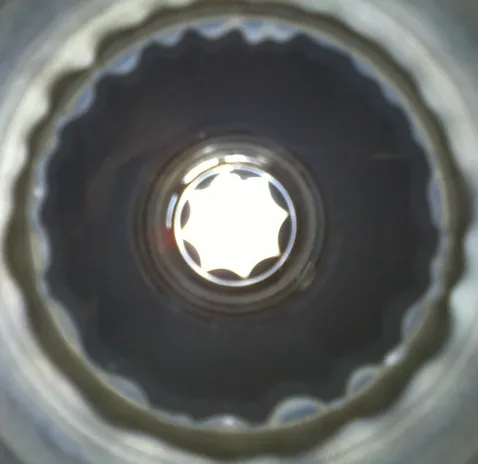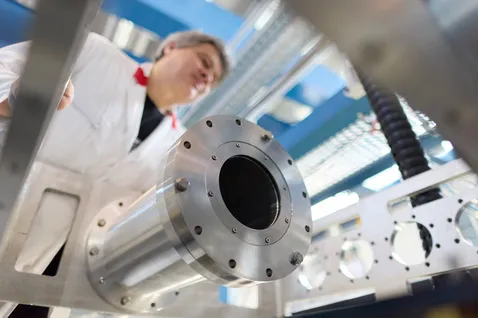What high pressure experiments with neutrons can tell about degradation of micro-plastics
Wissenschaft, KWS-3 |

Impact of high pressure on aggregation
Thermoresponsive polymers are long-chain molecules made of repeat units that show abrupt property changes triggered by temperature alteration, leading to chain collapse and phase separation in aqueous solution. Pressure plays a crucial role in the phase behaviour of such polymer solutions. A well-studied prototype is poly(N-isopropylacrylamide) (PNIPAM) with a phase transition temperature of ~ 32°C.
The team led by Prof. Christine M. Papadakis from the TUM School of Natural Sciences at the Technical University of Munich (TUM) and Prof. Dr. Alfons Schulte, University of Central Florida, USA, has focused on the impact of high pressure on the aggregation of the polymers and the disintegration of the such obtained particles. Below the phase transition temperature, PNIPAM is hydrophilic and water-soluble, whereas above, PNIPAM turns abruptly hydrophobic and collapses. Several PNIPAM chains form the so-called mesoglobules, i.e., long-lived particles having sizes of sub-micrometer size. “This intriguing property makes PNIPAM an ideal system for investigations of the particle formation and disintegration processes”, says Christine M. Papadakis.
Pressure alters the water content
The neutron scattering experiments demonstrate that high pressure alters the polymer hydration and hence the water content of the mesoglobules: These are small and compact at atmospheric pressure turning large and water-rich at high pressure. Using very small angle neutron scattering (VSANS), the team characterized the transition between these states and identified a transition line separating the low-pressure from the high-pressure regime, which provides an important test for computer simulations.
Detailed insights into the fabrics
Neutron scattering experiments, particularly at the VSANS instrument KWS-3 of the Forschungszentrum Jülich at the MLZ, demonstrated that the transition of the mesoglobules’ properties occurs at a pressure of ~ 500 times the atmospheric pressure. “KWS-3 is unique in this respect, as size and shape can be investigated in a non-destructive way around the micrometer length scale”, says Alfons Schulte. At high temperatures, the transition mainly proceeds via swelling of the mesoglobules, whereas at low temperatures, the mesoglobules mainly grow by coalescence. VSANS showed that this behavior is intimately linked to the water content of the mesoglobules and thus the mobility of the polymer chains. Upon decreasing the pressure again, the mesoglobules may take a long time to disintegrate because the chains need to disentangle again.
Importance for degradation mechanisms of micro-plastics
The formation and disintegration of polymeric aggregates are of high relevance for applications. “Such mechanisms play a central role in the degradation of micro-plastics in the sea or in the body, or polymeric release systems for medical drugs”, Christine M. Papadakis notes. Pressure and temperature changes have a significant impact on the stability and thus the degradation process of micro-plastics in aqueous systems.
The work goes beyond previous studies, as it depicts the structural changes in situ and relates them to the molecular interactions. It opens up a new approach for the characterization of more complex systems, such as polymer nanoparticles used for drug delivery or for the optimization of polymer recycling.
Original publications:
Bart-Jan Niebuur, Vitaliy Pipich, Marie-Sousai Appavou, Dharani Mullapudi, Alec Nieth, Eric Rende, Alfons Schulte, and Christine M. Papadakis:
PNIPAM Mesoglobules in Dependence on Pressure
Langmuir 40 (42), 22314, (2024)
https://doi.org/10.1021/acs.langmuir.4c02952
Christine M. Papadakis, Bart-Jan Niebuur, and Alfons Schulte
Thermoresponsive Polymers under Pressure with a Focus on Poly(N-isopropylacrylamide) (PNIPAM)
Langmuir 40 (1), 1 (2024)
https://doi.org/10.1021/acs.langmuir.3c02398
More information:
Researchers from the Technical University of Munich (TUM), the Forschungszentrum Jülich and the Heinz Maier-Leibnitz Zentrum (MLZ) in Garching have collaborated with scientists from the Department of Physics and the College of Optics and Photonics at the University of Central Florida. This work was supported by Deutsche Forschungsgemeinschaft.
Contact:
Prof. Christine M. Papadakis, Ph.D.
TUM School of Natural Sciences
Technical University of Munich
James-Franck-Str. 1, 85747 Garching
Tel.: +49 89 289 12447 – E-Mail: papadakis(at)tum.de

